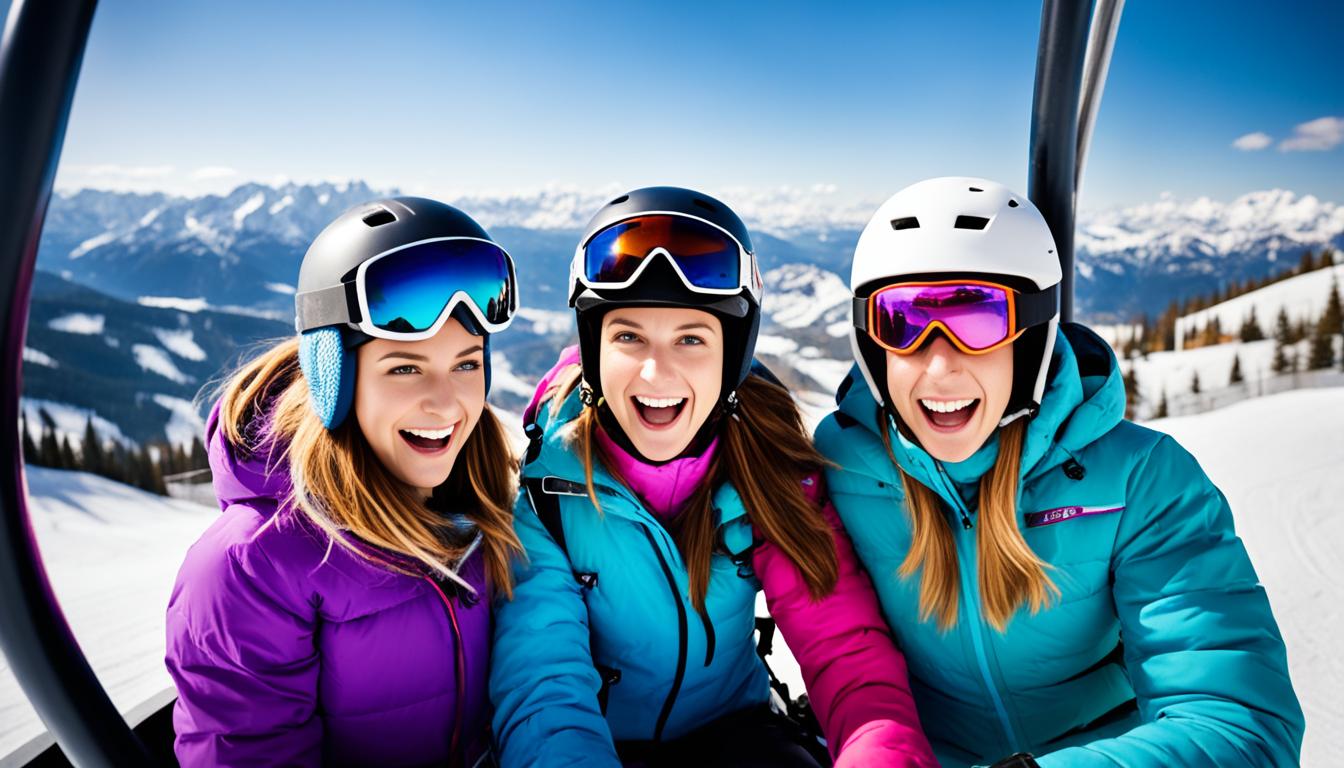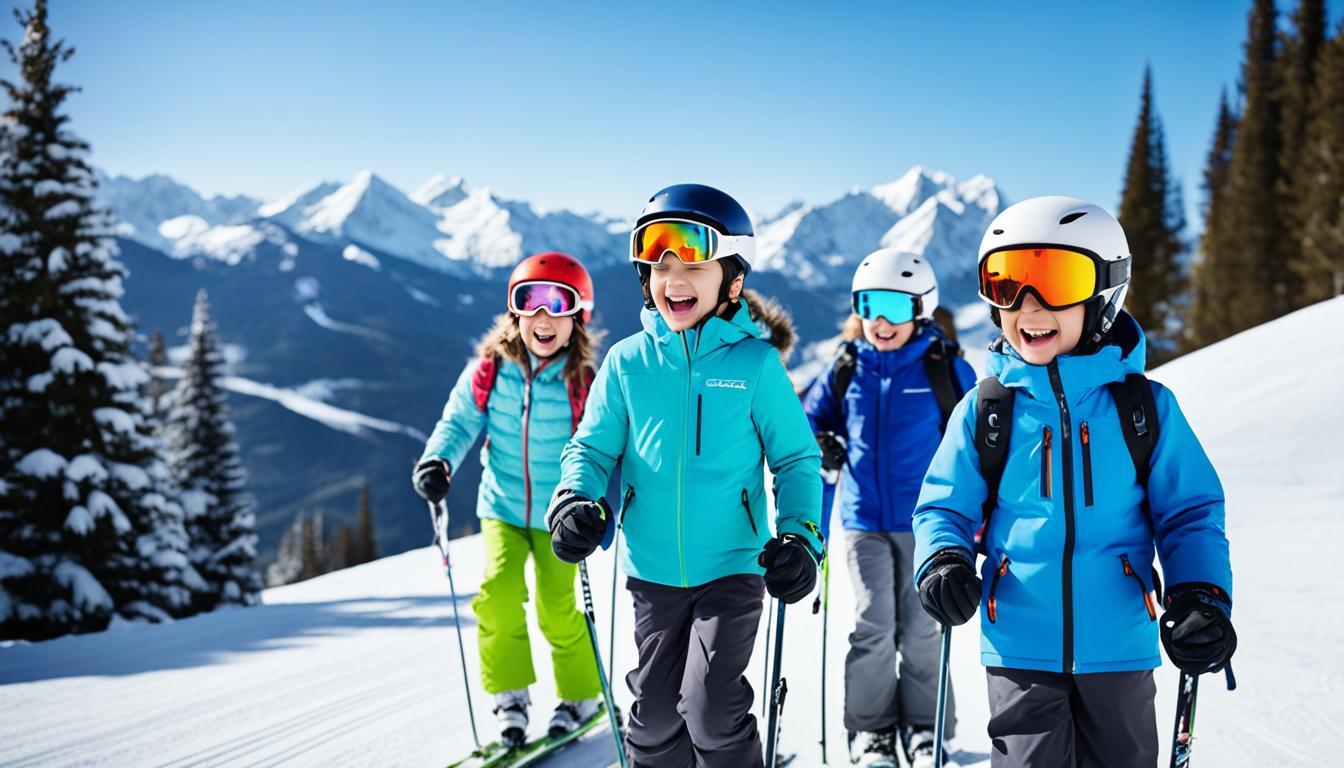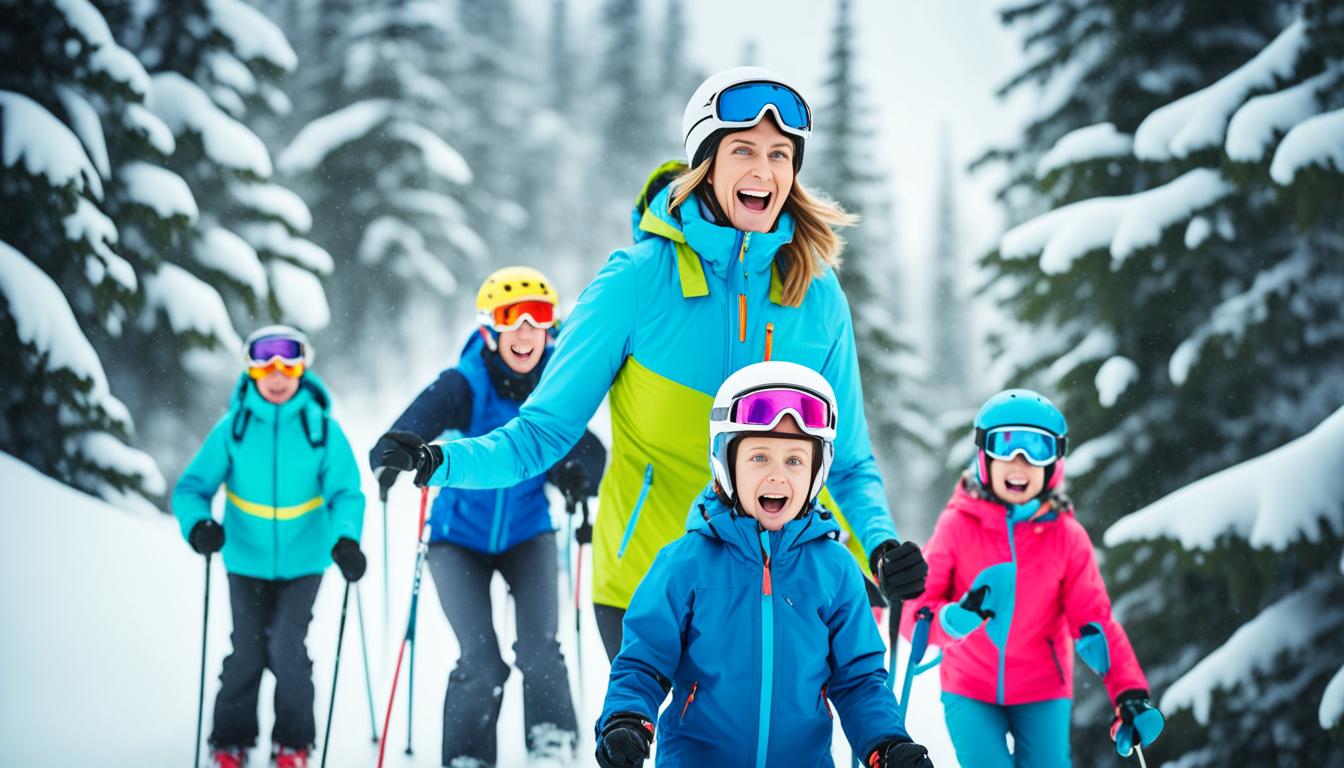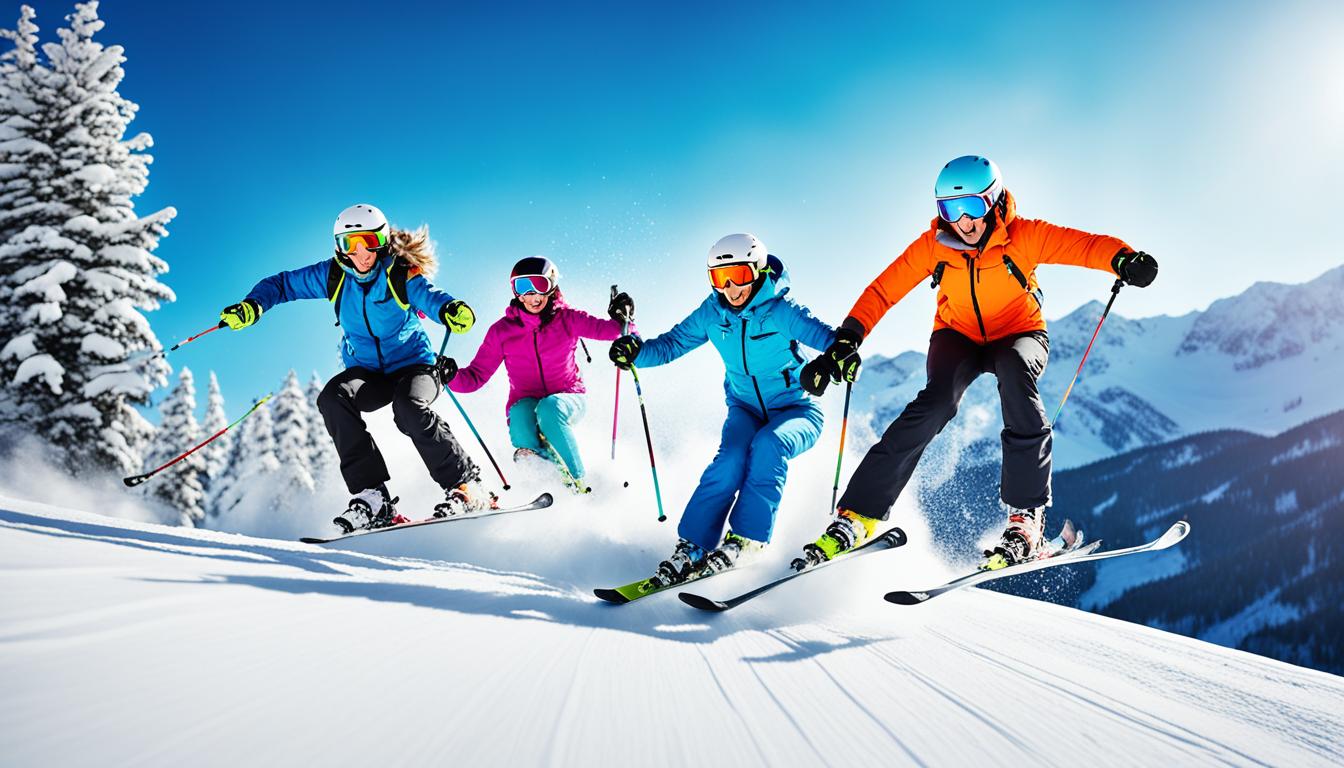Skiing is a fantastic winter sport that brings families together, and as we hit the slopes, it’s important to ensure that our teenagers stay engaged and excited. Providing them with a memorable and enjoyable skiing experience helps foster their love for winter sports and creates lasting memories.
With ski resorts offering a wide range of activities tailored specifically for teens, there’s no shortage of opportunities to keep them entertained. From ski school programs to dressing for success, here are some tips to maximize their enjoyment and safety on the slopes.
Key Takeaways:
- Provide engaging ski school programs to ensure teenagers learn proper techniques while having fun.
- Advise teenagers on dressing appropriately for the cold temperatures, emphasizing layering, warmth, and waterproof gear.
- Encourage teens to embrace falling as part of the learning process and to try again with support from ski school and fellow beginners.
- Choose ski runs suitable for their skill levels to avoid frustration and promote a positive skiing experience.
- Encourage regular breaks to prevent fatigue, hydrate, and reduce the risk of injuries.
Ski School Programs: Learning and Fun
When it comes to keeping teens entertained on the slopes, ski school programs are the perfect solution. At resorts like Steamboat Springs, youth skiing programs offer professional and engaging ski and snowboard lessons specifically designed for children and teenagers. These programs not only teach the proper techniques of skiing but also make learning fun and enjoyable.
With highly trained instructors and well-structured lesson plans, ski school programs provide a safe and supportive environment for teens to develop their skills on the slopes. Whether your teenager is a beginner or wants to advance their abilities, these programs cater to various skill levels and can help them progress at their own pace.
During ski school lessons, teens not only learn how to navigate the mountain but also gain a deeper understanding of snowsports and the mountain environment. From learning about terrain features to understanding the importance of safety, these programs provide a comprehensive learning experience.
“Ski school programs are designed to engage teenagers in a way that keeps them excited about skiing. We believe that when learning is enjoyable, teens are more likely to embrace the sport and continue exploring the slopes.” – Jane Thompson, Head of Ski School at Steamboat Springs
One of the advantages of ski school programs is the opportunity for teenagers to socialize and connect with other young skiers. They can form friendships and share their passion for winter sports, creating a sense of camaraderie and building confidence as they progress together.
Additionally, ski school programs often offer a variety of activities and adventures to complement the lessons. From fun competitions to themed days on the slopes, these programs ensure that teens are not only learning but also having a great time during their ski vacation.
Investing in a ski school program for your teenager is not only beneficial for their skiing skills but also for their overall enjoyment of the winter sports experience. It provides them with the knowledge, practice, and confidence they need to tackle the slopes with enthusiasm and make lasting memories.
Dressing for Success: Staying Warm on the Slopes
When hitting the slopes, it’s crucial for teenagers to dress appropriately to combat the cold temperatures. Not only does dressing right keep them comfortable, but it also helps them stay focused on enjoying their skiing experience. Here are some tips to ensure teenagers are prepared for the winter wonderland:
Layer Up
Layering clothing is key to regulating body temperature and staying warm on the slopes. Start with a moisture-wicking base layer to keep sweat away from the skin. Add a middle layer for insulation, such as a fleece or wool sweater. Finally, top it off with a waterproof and windproof jacket to protect against the elements.
Protective Gear
Wearing warm and waterproof gear is essential for a comfortable day on the slopes. Invest in quality ski pants that are both insulated and waterproof to keep legs warm and dry. Don’t forget about gloves or mittens, as well as a hat or helmet to protect the head from the cold. And of course, don’t overlook the importance of wearing high-quality socks and properly fitted boots to keep toes toasty.
Hand Warmers
Hand warmers are a great addition to any skiing outfit, especially in extremely cold weather conditions. These small, portable packets generate heat when activated and can easily be slipped into gloves or pockets to provide extra warmth.
By following these tips, teenagers can ensure they are properly dressed and ready to take on the slopes. Not only will they stay warm, but they’ll also be able to fully enjoy the ski resort activities, keeping them engaged and excited throughout their day in the snow.
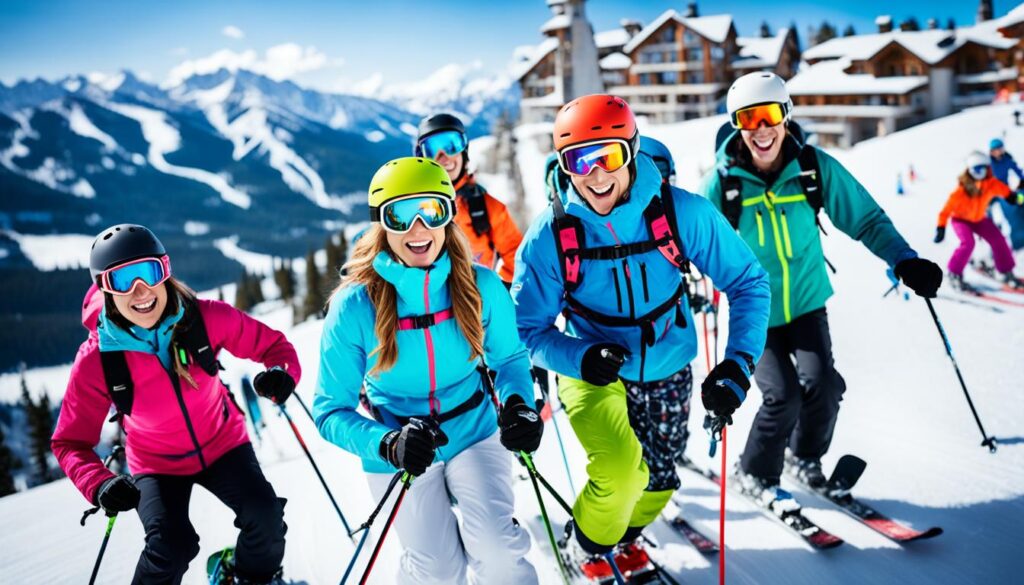
| Layering Clothing | Protective Gear | Hand Warmers |
|---|---|---|
| Moisture-wicking base layer | Waterproof ski pants | Portable and heat-generating |
| Fleece or wool sweater | Gloves or mittens | Slip into gloves or pockets |
| Waterproof and windproof jacket | Insulated and properly fitted boots |
Embracing Mistakes: The Importance of Falling
When it comes to winter sports for adolescents, learning to ski or snowboard can be both exciting and challenging. But one thing we need to remember is that falling is a natural part of the learning process. As teenagers hit the slopes, it’s important for them to understand that falling is completely normal and should be embraced as an opportunity to grow and improve their skills.
Encouraging teenagers to get back up and try again after a fall is essential for their progress. By fostering a mindset that mistakes are part of the journey, we can help them develop resilience, perseverance, and a positive attitude towards overcoming challenges. Ski school programs can play a crucial role in creating a supportive environment for teenagers to learn from their mistakes alongside other beginners.
At ski schools like Snowbird in Utah or Keystone in Colorado, trained instructors provide guidance and support, helping teenagers overcome their fears and build confidence on the slopes. Being surrounded by peers who are also navigating the learning process can be motivating and comforting, encouraging adolescents to push past their comfort zones and embrace the occasional tumble.
“The only real mistake is the one from which we learn nothing.” – John Powell
By embracing mistakes and falls as teaching moments, teenagers can grow both in their winter sports skills and in life. Each time they stumble and pick themselves up, they develop resilience, determination, and the ability to bounce back from setbacks. These valuable life lessons gained from winter sports can shape their character and empower them to face future challenges with confidence.
| Benefits of Embracing Falling: |
|---|
| 1. Growth mindset: Learning from mistakes fosters a mindset of continuous improvement and personal growth. |
| 2. Resilience: Overcoming falls cultivates resilience and the ability to bounce back from setbacks. |
| 3. Confidence: With each fall overcome, teenagers gain confidence in their ability to tackle challenges. |
| 4. Determination: Falling and getting back up instills determination, teaching the value of perseverance. |
| 5. Adaptability: Experiencing falls helps teenagers develop adaptability and problem-solving skills. |
Just as a ski jumper needs to fall several times before mastering their technique, so do teenagers learning to ski or snowboard. It’s important to remind them that every fall is simply a step forward on their journey to becoming confident and skilled winter sports enthusiasts.
Finding the Right Challenge: Choosing the Appropriate Slopes
When it comes to ski resort activities for teens, finding the right challenge on the slopes is essential. By choosing ski runs that match teenagers’ skill levels, we can ensure their safety and keep them engaged in the thrilling world of winter sports. Taking their abilities into consideration not only prevents frustration but also promotes a positive skiing experience that they will cherish.
It’s crucial to assess your teen’s skiing or snowboarding skills accurately. Be honest about their abilities and choose ski runs that align with their expertise. Beginners may find gentle slopes ideal for honing their skills, while more advanced teens can seek excitement on steeper terrain.
Keep in mind that ski resorts categorize their slopes based on difficulty levels. A helpful classification system is as follows:
| Slope Difficulty | Description |
|---|---|
| Green Circle | Beginner slopes with a gentle incline, perfect for novices. |
| Blue Square | Intermediate slopes with slightly steeper sections that offer a challenge for progressing skiers and snowboarders. |
| Black Diamond | Advanced slopes with steep pitches, moguls, and/or tight tree runs that require expert skills and confidence. |
By selecting the appropriate slopes, teens can experience the thrill of conquering new challenges while staying safe. Encourage them to push their limits gradually but intelligently, ensuring that they always enjoy themselves and continue to develop their abilities.
Expert Tip: Locating Skill-Focused Areas
Some ski resorts designate specific zones or parks dedicated to various skill levels. These areas can provide an excellent opportunity for teens to practice and showcase their talents. Look for terrain parks, half-pipes, or freestyle zones that cater to different skill levels, allowing teens to immerse themselves in their chosen discipline.
Remember, finding the right challenge is about balance. Pushing boundaries and taking calculated risks is part of the fun, but your teen’s safety is paramount. By selecting slopes that match their skill level and providing opportunities to advance, you can keep your teen engaged and excited as they discover the joys of skiing and snowboarding.
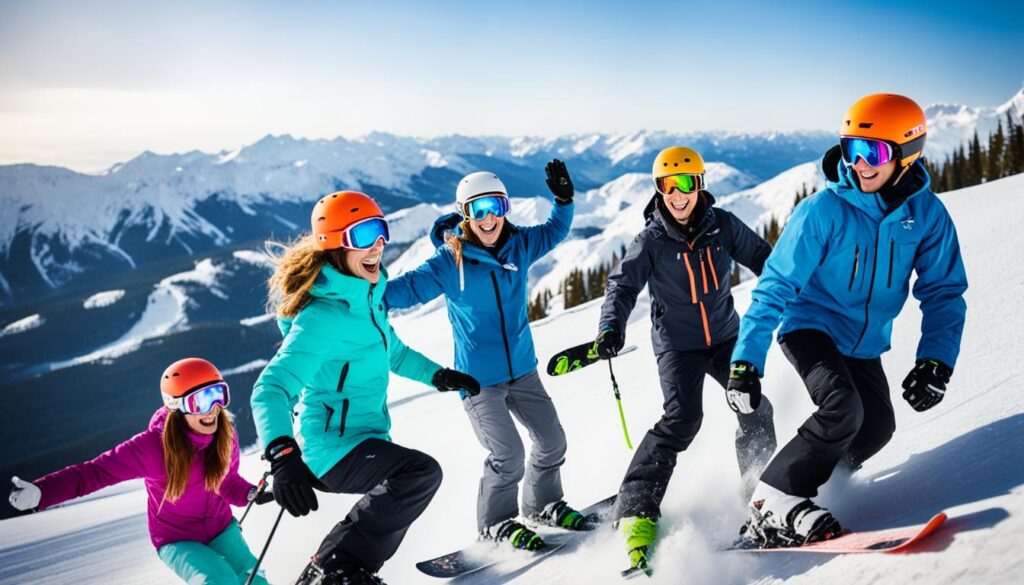
Taking Breaks: Preventing Fatigue and Overexertion
Skiing is a physically demanding sport, especially for adolescents who may tire more easily. To ensure their safety and well-being on the slopes, it’s essential for teens to take regular breaks, rest, hydrate, and recharge.
Why Taking Breaks is Important
Engaging in winter sports for adolescents requires a significant amount of physical exertion. Taking breaks helps prevent fatigue and overexertion, reducing the risk of accidents and injuries. By allowing time for rest and recovery, teens can maintain their energy levels and enjoy their ski resort activities to the fullest.
“Taking breaks is essential for adolescent skiers to prevent physical and mental fatigue. Sustained physical exertion without proper rest can lead to reduced performance, increased risk of injury, and decreased enjoyment of the sport.”
A study conducted by the National Ski Areas Association found that regular breaks during skiing sessions significantly decreased the occurrence of fatigue-related injuries among adolescents.
Hydration: The Importance of Staying Hydrated
Proper hydration is crucial for winter sports enthusiasts, especially during rigorous activities like skiing. Teens should drink plenty of water or sports drinks to replenish fluids lost through perspiration and prevent dehydration.
“Staying hydrated is essential for ski enthusiasts, as dehydration can lead to decreased performance, muscle cramps, and impaired decision-making abilities on the slopes.”
According to the American College of Sports Medicine, consuming fluids before, during, and after skiing activities is vital in maintaining optimal hydration levels and enhancing performance.
Recognizing Fatigue and Overexertion
It’s important for teens to understand the signs of fatigue and overexertion to prevent potential risks. Feeling excessively tired, experiencing muscle weakness, or losing concentration can indicate the need for a break.
Additionally, participating in non-skiing activities such as snowball fights or building snowmen during breaks can provide a fun and engaging alternative while allowing for recuperation.
| Signs of Fatigue and Overexertion | Recommended Actions |
|---|---|
| Exhaustion and excessive tiredness | Take a break, rest, and hydrate |
| Muscle weakness and soreness | Rest and perform gentle stretches |
| Loss of concentration or inability to focus | Take a break and engage in non-skiing activities |
By recognizing these signs and taking appropriate action, teens can avoid pushing themselves beyond their limits and enjoy a safe and fulfilling skiing experience.
Recognizing Triggers: Addressing Negative Experiences
When it comes to keeping teens entertained on the slopes and ensuring a positive winter sports experience, it’s essential to recognize potential triggers that may negatively impact their enjoyment. By identifying and addressing these triggers, we can create a more inclusive and enjoyable environment for adolescents.
Common Triggers to Consider
- Cold Toes: Freezing toes can quickly dampen a teenager’s enthusiasm for skiing. To combat this, encourage them to wear warm and properly insulated socks, invest in quality boots, and suggest using toe warmers for added comfort.
- Low Visibility: Poor visibility due to fog, snowfall, or night skiing can be disorienting and hinder a teenager’s confidence on the slopes. Advise them to wear goggles or a ski mask and choose well-marked runs to provide a clearer field of view.
- Crowded Slopes: Overly crowded slopes can make skiing feel chaotic and less enjoyable for teenagers. It’s important to select ski resorts that offer a variety of runs, allowing for more space and reducing the likelihood of overcrowding.
- Long Lift Lines: Waiting in long lift lines can be frustrating for teenagers eager to hit the slopes. Research ski resorts that offer efficient lift systems, consider visiting during non-peak times, or encourage teens to engage in other activities to make the waiting time more enjoyable.
“Addressing these triggers can help create a positive and enjoyable environment for teenagers, ensuring their winter sports experience is both engaging and entertaining.”
Creating a Positive and Enjoyable Environment
By recognizing and addressing these potential triggers, we can cultivate an environment that promotes the enjoyment and engagement of teenagers on the slopes. Ski resorts can implement strategies such as:
- Providing clear signage and trail maps to help teenagers navigate their way around the mountain and avoid confusion.
- Offering additional entertainment options besides skiing, such as snow tubing, snowshoeing, or ice skating, to keep teenagers entertained and engaged throughout their visit.
- Organizing ski races or freestyle competitions where teens can showcase their skills and feel a sense of accomplishment and camaraderie.
- Ensuring ski instructors are skilled in working with teenagers, offering positive reinforcement and guidance to help boost their confidence on the slopes.
By addressing triggers and creating a welcoming environment, we can enhance the winter sports experience for teenagers, allowing them to fully appreciate the thrill and joy of skiing or snowboarding.
Conclusion
When it comes to teen-friendly winter activities, keeping teenagers engaged and entertained on the slopes is key. By providing them with proper instruction and ensuring their safety, we can create an environment where they can have a memorable and enjoyable winter sports experience.
One way to achieve this is through ski school programs that offer professional and engaging lessons tailored specifically for teenagers. These programs not only teach proper techniques but also make learning fun and exciting. So, whether your teen is a beginner or more advanced, they can benefit from these youth skiing programs.
Additionally, dressing appropriately for the cold temperatures is essential to keeping teens comfortable and focused on enjoying the skiing experience. Layering clothing, wearing warm and waterproof gear, and using hand warmers can make a huge difference in their overall enjoyment of the sport.
Lastly, it’s important to create a positive environment by addressing any negative experiences that may arise. Identifying triggers such as cold toes, low visibility, crowded slopes, or long lift lines can help us address these issues proactively, ensuring a more enjoyable time for our teenage skiers.
FAQ
How can I keep teenagers engaged on the slopes?
To keep teenagers engaged on the slopes, it’s important to provide them with fun and interactive activities. Ski resorts often offer snowsports school programs that provide professional and engaging ski and snowboard lessons for children and teenagers.
How can ski school programs benefit teenagers?
Ski school programs provide teenagers with the opportunity to learn proper skiing or snowboarding techniques while keeping it fun and enjoyable. These programs are designed to cater to teenagers’ needs and help them improve their skills on the slopes.
How should teenagers dress for skiing?
Teenagers should dress appropriately for the cold temperatures on the slopes. This includes layering clothing, wearing warm and waterproof gear, and using hand warmers to stay comfortable and focused on enjoying the skiing experience.
Is falling part of the learning process for teenagers learning to ski?
Yes, falling is a natural part of learning to ski or snowboard. It’s important for teenagers to understand that falling is normal, and they should be encouraged to get back up and try again. Ski school and being around other beginners can provide a supportive environment for learning from mistakes.
How can I choose the right ski runs for teenagers?
It’s crucial to choose ski runs that match teenagers’ skill levels to ensure their safety and enjoyment. By considering their abilities, you can help avoid frustration and promote a positive skiing experience.
Should teenagers take breaks while skiing?
Yes, skiing can be physically demanding, especially for teenagers who may tire more easily. It’s important for teenagers to take breaks to rest, hydrate, and recharge to prevent exhaustion and reduce the risk of injury.
What triggers should I be aware of while skiing with teenagers?
It’s important to be aware of potential triggers that may negatively impact a teenager’s skiing experience. These triggers could include cold toes, low visibility, crowded slopes, or long lift lines. Identifying and addressing these triggers can help create a positive and enjoyable environment.
How can I keep teenagers entertained on the slopes?
Keeping teenagers engaged and entertained on the slopes is crucial to fostering a love for skiing and snowboarding. By providing them with proper instruction, ensuring safety, and creating a positive environment, they can have a memorable and enjoyable winter sports experience.

